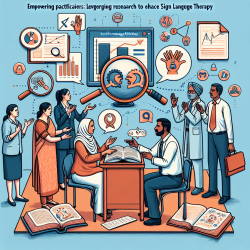As practitioners dedicated to creating the best outcomes for children, we must constantly evolve and adapt our methods based on the latest research. One such impactful study, "Handling Sign Language Data: The Impact of Modality," offers valuable insights into how we can refine our approaches in sign language therapy. By understanding and implementing the findings from this research, we can significantly enhance our practice and improve the communication skills of our young clients.
Understanding the Research
The study by Quer and Steinbach (2019) delves into the complexities of sign language data collection and the unique challenges posed by the visual-gestural modality. Unlike spoken languages, sign languages involve multiple articulators such as hands, upper body, head, and face, which simultaneously express grammatical features. This multimodal nature necessitates careful consideration in data elicitation and experimental studies.
Key Takeaways for Practitioners
Here are some actionable insights from the research that can be directly applied to improve sign language therapy:
- Holistic Data Collection: When collecting data from children, ensure that all aspects of their signing, including non-manual markers like facial expressions, are captured. This comprehensive approach provides a more accurate representation of their communication skills.
- Use of Native Signers: Whenever possible, involve native signers in your practice. Native signers offer a richer and more natural language model, which is crucial for effective language acquisition in children.
- Multimodal Elicitation Techniques: Incorporate a variety of elicitation techniques that account for the visual-gestural nature of sign languages. This could include video recordings, interactive signing activities, and real-time feedback sessions.
- Ethical Considerations: Always adhere to the highest ethical standards when working with sign language data. Ensure that your data collection methods respect the privacy and dignity of the children and their families.
Encouraging Further Research
The study also highlights the need for ongoing research to address the unique challenges of sign language data. As practitioners, we should advocate for and participate in research initiatives that aim to refine our understanding and methodologies in sign language therapy. By contributing to the body of knowledge, we not only enhance our practice but also pave the way for future advancements in the field.
Conclusion
Incorporating the findings from "Handling Sign Language Data: The Impact of Modality" into our practice can lead to more effective and nuanced sign language therapy. By leveraging data-driven decisions and staying informed about the latest research, we can continue to create exceptional outcomes for the children we serve.
To read the original research paper, please follow this link: Handling Sign Language Data: The Impact of Modality.










